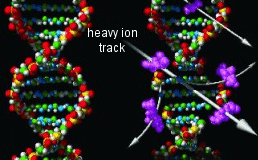|
DNA researchers are learning how to snag strands
of DNA and examine them one by one under a microscope.
by Karen Miller and Dr Tony
Phillips
In a pot of boiling
water, spaghetti's a tangled mess. But let's say you want to look
at a piece more closely. Simple. Just hook a strand around the handle
of a wooden spoon and it straightens out quite nicely. You can examine
it easily.
NASA-supported bioengineer
Susan
Muller of UC Berkeley wants to do the same thing to DNA.
When researchers get
a sample of DNA for analysis it's often a tangled mess of coiled
strands - just like that pot of spaghetti. They analyse it by chopping
the strands into pieces, cloning the fragments, sequencing the pieces,
sorting them according to size and, finally, fitting them back together
again. In short, it's a complex and time-consuming process.
Muller and colleague
Eric Shaqfeh are working on a more straightforward procedure - a
way to stretch out a single strand of DNA for examination by a standard
laboratory microscope.
Why does NASA care?
Because astronauts have DNA.
"Astronauts in space
are exposed to radiation, and this can damage their DNA," explains
Frank Cucinotta of NASA's Space Radiation Health Program. Of particular
concern are heavy cosmic rays - the energetic nuclei of iron atoms,
for instance - which can crash through DNA like little atomic cannonballs,
causing complex breaks called "clustered DNA damage."

Credit OBPR
An artist's concept
of DNA battered by heavy ions from space.
|
"We know that cells
on Earth have not evolved to be competent in repairing such damage,"
he says. New DNA analysis tools are needed "to study the problem
and develop remedies."
To snag DNA for study,
Muller uses a carefully devised fluid flow in a device just a few
millimetres long. A flow device, with its tiny linked pools and
channels, can be simple or maze-like in design. One that's shaped
like a cross, for instance, with fluid flowing in through two arms
and out through the opposite two, is very effective at stretching
DNA. Muller's device is a bit more complicated than this; it not
only stretches the DNA but also allows her to tag the DNA with fluorescent
markers and to photograph the glowing strands.
The DNA she's working
with is from a virus that infects bacteria. "It's a very popular
DNA with bioengineers," she says. "It has about 48 thousand base
pairs (or 48,000 rungs in the DNA ladder). Under quiescent conditions,
if it's just floating in solution, it has a size of about .7 microns.
But it you were to stretch it out completely, it would be about
22 microns in length" - about 10 times longer than a typical bacterium.

(A) a
micro flow device designed by A. Deshmukh and co-workers.
The central element is free floating and can be moved
by the fluid. (B) glowing streaks trace fluid pathways
through the device. "The flow was seeded with fluorescent
microspheres," explains Muller. "Long-exposure photographs
of the spheres were taken to reveal the details of the
flow."
|
To stretch and hold
the fragile strands, a carefully spaced array of posts interrupts
the flow. "If you have a forest of posts in the flow - a little
set of obstacles - then the DNA loops around them, and gets stuck
and stretched as it tries to unwind from the posts," she explains.
Once a strand is stretched,
Muller uses fluorescent markers that locate and latch onto interesting
areas of the DNA. The stretching makes it easier for the researchers
to locate where the markers are. It also makes it easier for the
markers to find their target sites: when the DNA is stretched out,
the markers don't have to penetrate the tangles of coiled-up DNA.
Protecting astronauts
from deep-space radiation is a still-unsolved problem, and one that
must be successfully tackled before deep space can be safely explored.
Most approaches to the problem rely on shielding, and on limiting
astronaut exposure.

Images
of individual DNA molecules flowing through the micro
flow device at positions denoted by letters A through
G. "The DNA is stretched and rotated by the flow. DNA
stretching is greatest in regions of high flow acceleration,"
says Muller.
|
Muller's work suggests
the possibility of finding astronauts who themselves are more resistant.
Just as some versions of genes are more prone to the mutations that
lead to problems like breast cancer, others may be more easily damaged
by the intense radiation of deep space. "You might use this device
to seek out individuals who are not at high risk for these
particular types of mutations," she speculates. "You'd be looking
for particular genes, or for particular sequences within a gene,
that were correlated with 'radiation toughness.'"
Because her method
is so straightforward, it might lend itself to a future technology:
portable DNA analyser's. Astronauts on long space voyages could
take one along and test their own genes for radiation damage. At
the first sign of trouble they could take precautions: avoiding
space walks or spending the rest of the journey in heavily-shielded
parts of the ship.
DNA "biosentinels,"
as Muller calls them, would benefit more people than just astronauts.
The devices could be used to examine anyone's genes for, say, the
tendency to develop a certain illness or to react in a particular
way to a medication. Medical researchers, criminologists, pharmaceutical
manufacturers: they would all like to have one.
That's in the future,
though. Meanwhile, says Muller, "there's a lot of basic fundamental
science that going to come out of understanding how to use flow
to manipulate large molecules. There are still many challenges to
making this work and a lot of interesting questions I think we're
going to answer along the way."
|
